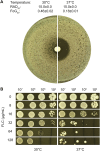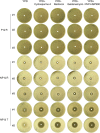Parallel evolution of fluconazole resistance and tolerance in Candida glabrata
- PMID: 39397866
- PMCID: PMC11466938
- DOI: 10.3389/fcimb.2024.1456907
Parallel evolution of fluconazole resistance and tolerance in Candida glabrata
Abstract
Introduction: With the growing population of immunocompromised individuals, opportunistic fungal pathogens pose a global health threat. Candida species, particularly C. albicans and non-albicans Candida species such as C. glabrata, are the most prevalent pathogenic fungi. Azoles, especially fluconazole, are widely used therapeutic options.
Objective: This study investigates how C. glabrata adapts to fluconazole, with a focus on understanding the factors regulating fluconazole tolerance and its relationship to resistance.
Methods: This study compared the factors regulating fluconazole tolerance between C. albicans and C. glabrata. We analyzed the impact of temperature on fluconazole tolerance, and requirement of calcineurin and Hsp90 for maintenance of fluconazole tolerance. We isolated colonies from edge, inside and outside of inhibition zone in disk diffusion assays. And we exposed C. glabrata strain to high concentrations of fluconazole and investigated the mutants for development of fluconazole resistance and tolerance.
Results: We found temperature modulated tolerance in the opposite way in C. albicans strain YJB-T1891 and C. glabrata strain CG4. Calcineurin and Hsp90 were required for maintenance of fluconazole tolerance in both species. Colonies from inside and outside of inhibition zones did not exhibited mutated phenotype, but colonies isolated from edge of inhibition zone exhibited diverse phenotype changes. Moreover, we discovered that high concentrations (16-128 μg/mL) of fluconazole induce the simultaneous but parallel development of tolerance and resistance in C. glabrata, unlike the sole development of tolerance in C. albicans.
Conclusion: This study highlights that while tolerance to fluconazole is a common response in Candida species, the specific molecular mechanisms and evolutionary pathways that lead to this response vary between species. Our findings emphasize the importance of understanding the regulation of fluconazole tolerance in different Candida species to develop effective therapeutic strategies.
Keywords: Candida glabrata; Hsp90; antifungal resistance; antifungal tolerance; calcineurin; evolution trajectory.
Copyright © 2024 Zheng, Xu, Wang, Dong and Guo.
Conflict of interest statement
The authors declare that the research was conducted in the absence of any commercial or financial relationships that could be construed as a potential conflict of interest.
Figures






Similar articles
-
Global analysis of the evolution and mechanism of echinocandin resistance in Candida glabrata.PLoS Pathog. 2012;8(5):e1002718. doi: 10.1371/journal.ppat.1002718. Epub 2012 May 17. PLoS Pathog. 2012. PMID: 22615574 Free PMC article.
-
The stress-protectant molecule trehalose mediates fluconazole tolerance in Candida glabrata.Antimicrob Agents Chemother. 2025 Mar 5;69(3):e0134924. doi: 10.1128/aac.01349-24. Epub 2025 Jan 24. Antimicrob Agents Chemother. 2025. PMID: 39853120 Free PMC article.
-
PKC signaling regulates drug resistance of the fungal pathogen Candida albicans via circuitry comprised of Mkc1, calcineurin, and Hsp90.PLoS Pathog. 2010 Aug 26;6(8):e1001069. doi: 10.1371/journal.ppat.1001069. PLoS Pathog. 2010. PMID: 20865172 Free PMC article.
-
Candida and candidaemia. Susceptibility and epidemiology.Dan Med J. 2013 Nov;60(11):B4698. Dan Med J. 2013. PMID: 24192246 Review.
-
Molecular epidemiology, antifungal susceptibility, and ERG11 gene mutation of Candida species isolated from vulvovaginal candidiasis: Comparison between recurrent and non-recurrent infections.Microb Pathog. 2022 Sep;170:105696. doi: 10.1016/j.micpath.2022.105696. Epub 2022 Jul 31. Microb Pathog. 2022. PMID: 35921954 Review.
Cited by
-
Uncovering the connection between tunicamycin-induced respiratory deficiency and reduced fluconazole tolerance in Candida glabrata.Front Microbiol. 2025 Apr 28;16:1528341. doi: 10.3389/fmicb.2025.1528341. eCollection 2025. Front Microbiol. 2025. PMID: 40356653 Free PMC article.
-
Genomics insights of candidiasis: mechanisms of pathogenicity and drug resistance.Front Microbiol. 2025 Feb 27;16:1531543. doi: 10.3389/fmicb.2025.1531543. eCollection 2025. Front Microbiol. 2025. PMID: 40083780 Free PMC article. Review.
-
Understanding adaptation to fluconazole: comparative insights into tolerance and resistance in Saccharomyces cerevisiae and Candida albicans.Front Cell Infect Microbiol. 2025 May 5;15:1519323. doi: 10.3389/fcimb.2025.1519323. eCollection 2025. Front Cell Infect Microbiol. 2025. PMID: 40391048 Free PMC article.
-
Antifungal drug resistance in Candida glabrata: role of cellular signaling and gene regulatory networks.FEMS Yeast Res. 2025 Jan 30;25:foaf025. doi: 10.1093/femsyr/foaf025. FEMS Yeast Res. 2025. PMID: 40378148 Free PMC article. Review.
-
Understanding the mechanisms of resistance to azole antifungals in Candida species.JAC Antimicrob Resist. 2025 Jun 23;7(3):dlaf106. doi: 10.1093/jacamr/dlaf106. eCollection 2025 Jun. JAC Antimicrob Resist. 2025. PMID: 40583995 Free PMC article. Review.
References
-
- CLSI (2009) in 2nd ed (Wayne, PA: C.a.L.S. Institute; ).
MeSH terms
Substances
LinkOut - more resources
Full Text Sources

